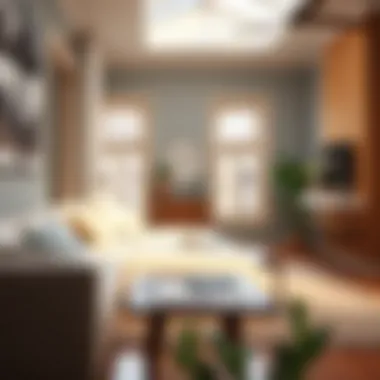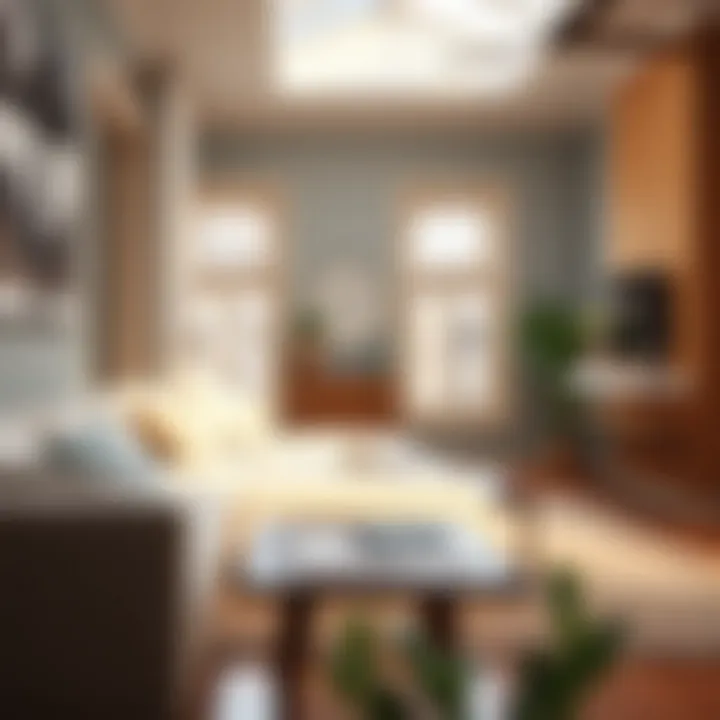Cost Breakdown for Painting a 1000 Sq Ft Home


Intro
Painting a house is not just about brushing on a fresh coat of color; it's a significant decision that can impact both the aesthetic value and overall living environment. For homeowners looking at a 1000 square foot space, understanding the costs involved can be a daunting task. Many factors influence these costs including the type of paint chosen, labor expenses, and any additional fees that might sneak in. This article aims to clarify these complexities, equipping you with the necessary insights to make informed financial decisions regarding your painting project.
Balancing costs while maintaining quality is often the crux of the problem. Homeowners can find themselves juggling between cheap paints that might peel in no time and more expensive options that seem daunting. Entering the world of home painting without doing your homework can lead to overspending or getting unsatisfactory results. By assessing your needs thoroughly and planning ahead, you can steer clear of financial pitfalls.
It’s essential to realize that the expenses involved in painting your home go beyond just the visible paint. Hidden costs, such as prep work and cleanup, can dramatically raise the final bill. The subsequent sections of this article will break down those crucial components, assist you in budgeting, and offer practical tips on how to save without sacrificing quality.
Understanding these elements will not only help preserve your home’s value but can also facilitate a smoother painting process.
Factors Influencing Painting Costs
When delving deeper into the financial aspects of painting your home, it’s crucial to recognize the primary elements that contribute to the overall costs.
Paint Type
The choice of paint significantly affects the budget. Different types of paints serve varying purposes:
- Acrylic latex paints are a common choice for their durability and ease of cleanup.
- Oil-based paints often outperform in shiny finishes and are ideal for trimming and molding, yet they take longer to dry.
- Eco-friendly paints, while more expensive, are gaining traction among environmentally-conscious homeowners.
Each paint type has its pros and cons when it comes to price, so weigh the costs against your needs.
Labor Costs
Another significant expense in painting is labor. Hiring professionals can range widely depending on their experience, demand in your area, and the complexity of the job. For the DIY enthusiast, consider whether you possess the necessary skills and time, as mishaps can lead to more costs later on.
- If you’re looking to save, enlisting friends or family to help might be a viable option, provided you have the right tools.
- Alternatively, always get multiple quotes from professional services – estimates can vary remarkably, and bargaining might trim costs further.
Additional Expenses
Hidden costs often rear their heads during painting projects. Some expenses to keep an eye on include:
- Preparation costs: This encompasses repair work, sanding, and cleaning surfaces.
- Tools and supplies: Brushes, rollers, tape, and drop cloths might seem minor, but they add up quickly.
- Cleanup costs: Don’t forget about the cost associated with disposing of leftover paint and cleaning supplies.
By being aware of these potential hidden costs, you can budget more realistically.
Culmination
Investing the time to educate yourself on these factors can help transform your space without breaking the bank. As you venture into the realm of home painting, keep your eyes peeled for potential savings and always remember – well-informed decisions often lead to satisfying results.
Overview of House Painting Costs
When it comes to home improvement, few projects have the potential to refresh and rejuvenate a property quite like painting. Understanding the costs involved in painting a 1000 square foot house is imperative for homeowners to make informed decisions and ensure that they get the most bang for their buck. The financial implications can be significant, and without a grasp of these costs, one might find themselves in a pickle.
The cost of painting a house goes beyond just the paint itself. It encompasses a spectrum of considerations, from labor to the kind of finish desired. This article seeks to shed light on the various elements at play when budgeting for a painting project. Homeowners should be aware that the average cost can be deceptive without an understanding of the factors that contribute to price variations and overall expenditures.
Defining the Average Cost
To pin down the average cost of painting a 1000 square foot house, one must first break it down into core components. Generally speaking, homeowners can expect to spend between $1,500 to $4,000. This range largely depends on several factors, including:
- The quality of paint selected
- Whether or not prep work is required
- Local labor costs, which can vary dramatically by region
It’s essential to specify that this average does not merely reflect the direct costs associated with paint but also includes labor fees, which can take up a significant chunk of the budget. Additionally, costs may delve deeper depending on the structural specifics of the house. For instance, a two-story house will generally incur more expenses than a single-story home due to the additional labor and potential costs of scaffolding.
Factors Influencing Price Variation
Like a chameleon on a plaid background, the cost of painting a house can shift based on multiple aspects. Some of the key factors to consider include:
- Region: Variations in labor costs are substantial based on geographical location. Different states may have minimum wage laws or prevailing wage rates that affect the overall cost of labor.
- Paint Quality: There exists a spectrum of paint products on the market, from budget options to premium brands. Investing in high-quality paint can lead to lower long-term maintenance costs since better materials typically have increased durability.
- Home Condition: If the exterior of the house requires repairs or extensive prep work due to a worn-out finish, potential costs will escalate. Surfaces might need sanding, priming, or even repair work before painting can commence.
- Design Choices: If a homeowner desires intricate designs or multiple color schemes, artistry often translates to increased costs. Detail-oriented projects may require skilled laborers, leading to a higher total.
- Seasonal Demand: The time of year can also play a role. For example, autumn often sees more demand in certain areas, which can push prices up for both materials and labor as homeowners rush to complete work before winter sets in.
Understanding these factors allows homeowners to construct a more accurate financial plan and also to delve into necessary negotiations with contractors, if applicable.
Estimating Costs per Square Foot
When you're setting out to paint a house, understanding how to estimate costs per square foot is crucial. This step serves as the backbone of your budgeting efforts. It’s not just about slapping some paint on the walls; you need to take a closer look at what that entails. Knowing the costs on a per-square-foot basis allows you to project the total expense more accurately, preventing any rude surprises along the way.
From paint type to preparation, every element contributes to the final figure. Grasping how prices stack up can give you the upper hand when negotiating with contractors or planning your DIY project. Moreover, it leads to better decision-making in terms of materials, labor, and overall project management.
Standard Pricing Models
When it comes to housing painting, there are standardized pricing models that most professionals adhere to. On average, contractors might charge anywhere from $2 to $6 per square foot for interior painting, depending on labor costs and the quality of materials used. However, this is just a ballpark figure; specific conditions can alter this significantly.
For instance, here are some common pricing models to consider:
- Basic Coverage: If a simple coat of paint is all that's needed, expect to lean toward the lower end of the pricing spectrum.
- Higher-End Finishes: If you're considering conventional higher-end brands like Benjamin Moore or Sherwin-Williams, costs can leap to the higher end of $5-$6 per square foot due to the expense of materials and labor associated with proper application.
It's also worth noting that many contractors may include costs related to prep work—cleaning, sanding, and patching—as part of their estimate. Always go through the quote in detail to see what is included.
Regional Differences in Labor Costs
One cannot overlook the impact of regional differences on labor costs when estimating your painting expenditure. The workforce's cost varies widely based on geographical location. For instance, hiring professionals in a bustling city like New York might set you back significantly more than if you were in a quieter town in the Midwest.
To break it down:
- Urban Areas: Costs tend to soar due to the higher living expenses. You might find labor rates ranging from $3 to $8 per square foot.
- Rural Areas: On the flip side, a more serene lifestyle often translates to lower labor costs, generally sitting around $2 to $5 per square foot.
Additionally, fluctuating demand in different regions can change pricing as well. During peak seasons, when everyone is rushing to beautify their homes, rates might rise significantly. Similarly, during off-peak seasons, you may find more competitive pricing and available deals.
Type of Paint and its Impact
Choosing the right type of paint is crucial when undertaking a house painting project. The type of paint not only affects the overall appearance but it also plays a significant role in cost, durability, and maintenance. Understanding these factors can provide you with a clearer picture and assist in making informed decisions that align with your budget and aesthetic preferences.
Choosing Between Latex and Oil-Based
When it comes to house painting, one of the first decisions to tackle is whether to go with latex or oil-based paint. Each has its merits, and recognizing these can help you avoid potential pitfalls.
Latex Paint:
- Water-Soluble: Easy to clean up with just soap and water, making it a user-friendly option.
- Quick Drying: Generally dries faster than oil-based paints, allowing for quicker project completion.
- Breathability: Allows moisture to escape from walls, so mold and mildew are less likely to become an issue.
However, latex paint may not adhere as well to certain surfaces and might need a primer depending on your walls' current condition.
Oil-Based Paint:


- Durable Finish: Often provides a harder, more durable finish that stands up well to wear and tear.
- Glossy Finish: Particularly good for surfaces that require regular cleaning, such as trim and molding, as it holds up against scuffs better.
- Great for Stains: Oil-based paints can cover stains effectively, which is valuable if you're painting over problem areas.
On the downside, oil-based paints take longer to dry and require solvents for clean-up, which can complicate the process. Furthermore, they emit stronger fumes, which is something to consider if you have indoor air quality concerns. In sum, if you are after a project that allows for flexibility, latex may be your friend, while oil-based could be your go-to for durability and coverage.
Finish Options and Their Costs
The finish of paint is yet another critical decision that can influence both aesthetic appeal and cost. The finish can dictate how light interacts with the surface, affecting the perception of your space.
- Matte Finish:
- Satin Finish:
- Semi-Gloss Finish:
- Glossy Finish:
- Offers a non-reflective look, making it great for hiding imperfections. However, it's not the most durable option, often requiring more frequent touch-ups.
- Costly for a flat finish is usually on par with mid-range prices, around $25 to $40 per gallon.
- Slightly more reflective than matte, satin finishes are flexible and suitable for many indoor settings like living rooms or dining areas. They provide some washability, making them easier to maintain.
- Prices typically range from $30 to $50 per gallon.
- This finish shines more, making it ideal for kitchens and bathrooms where cleanliness is a priority. It provides a durable surface, meaning it can withstand scrubbing.
- Generally, you can expect to pay about $35 to $55 per gallon for semi-gloss.
- Offering a high-shine look, glossy finishes can make rooms feel brighter. They are ideal for areas that require frequent cleaning, like trim and cabinetry.
- However, the cost for glossy finishes often starts from $40 per gallon and can jump higher depending on brand and quality.
Ultimately, the type of paint and its finish not only define the look of your house but also affect the ongoing costs associated with upkeep. Choose wisely.
Labor Costs Breakdown
When it comes to House painting, labor costs often make up a significant portion of the total expenses. Understanding these costs is crucial for homeowners intent on budgeting accurately for their projects. It’s not just about throwing a few bucks at someone with a brush; it’s about recognizing the intricacies of skills and time involved. In this section, we will dissect the financial implications of choosing between do-it-yourself (DIY) methods versus hiring professional services, as well as provide an overview of the time estimates required for each, ensuring you stay informed and ahead of the game.
DIY vs. Professional Services
Choosing between DIY and professional painting services can feel like choosing between a rock and a hard place- it’s a tough selection that many homeowners grapple with. Here are some considerations to mull over:
- Skill Level: How adept are you with a paintbrush or roller? If you’re more comfortable navigating a remote than mastering the nuances of wall finishes, hiring a professional painter might be the wiser choice.
- Time Commitment: A high-quality paint job often requires meticulous prep work, which can be time-consuming. Ask yourself, do you have the days (or even weeks) to dedicate to the task, or do you prefer to leave it to seasoned hands that can get it done quicker?
- Cost Efficiency: While DIY may seem cheaper initially, don’t overlook potential hidden costs. Mistakes can lead to costly touch-ups or even having to hire a professional to fix errors.
- Quality of Finished Work: Professionals usually bring in not just experience but also access to tools and materials that even the most prepared DIY-er might lack.
"Time is money, and if you spend too much time painting yourself, it may negate any savings you hoped to achieve."
Time Estimates for Completion
Estimating how long it’ll take to paint your home can be as tricky as nailing Jell-O to a wall. Factors like the size of your home, the number of coats needed, and the state of your walls all come into play.
- DIY Projects: A DIYer can expect to take anywhere from a few days to over a week to finish up the job, depending on complexity. Keep in mind the prep work alone—cleaning, patching, or priming—can add hours.
- Professional Services: On the other hand, a professional crew may knock out the same job in a fraction of that time. Most teams can usually complete the painting process for a 1000 square foot house in 1 to 3 days. Less time spent on-site generally means less labor cost, though factors like travel distance to the job site can intrude upon schedule estimates.
In summary, weighing the benefits and drawbacks of either route can lend clarity as you work through your painting plans. The labor costs breakdown is not just numbers on a spreadsheet; it’s about understanding your options, time commitments, and ultimately how you want the finished product to translate into the beauty of your home.
By understanding these labor elements, you'll be more equipped to make decisions that align with your budget and expectations.
Additional Expenses to Consider
When budgeting for a house painting project, it is essential to recognize that the cost of paint and labor is just the tip of the iceberg. Additional expenses can significantly impact your overall budget, and overlooking them can lead to unexpected financial strains. The expenses that often go unnoticed are the prep work, repairs, and equipment or supplies required to complete the job correctly.
Understanding these costs is crucial for homeowners planning a painting project. Properly addressing these can save trouble further down the line while ensuring a better finish and longer-lasting results. Here’s a closer look at what these additional costs might entail.
Prep Work and Repairs
Before a single drop of paint is applied, a house usually needs considerable prep work. This can include everything from scraping and sanding old paint to patching holes and repairing damaged siding. Why is this prep work necessary?
- Surface Integrity: Without proper prep, paint cannot adhere well, leading to peeling or bubbling in the future. Imagine spending all that money on a fresh coat only to see it deteriorate within a year. Not what you want.
- Uniform Finish: Preparing the surfaces ensures that you get a smooth and even finish. Any flaws on the surface can shine through, making the whole project look unprofessional.
Here are some common prep tasks to consider:
- Cleaning Surfaces: Removing dirt, mildew, and old paint residue is critical. Pressure washing can help with this.
- Minor Repairs: Filling cracks and holes or replacing damaged wood can seem minor but can add up.
- Sanding: If you’re working with rough surfaces or old paint, sanding creates a better foundation for the new coat.
Neglecting prep means potentially higher costs down the line when the paint fails prematurely. It's often said that "an ounce of prevention is worth a pound of cure," and that adage is especially true for painting.
Equipment and Supplies Costs
Besides labor and paint, you must consider the tools and materials required to complete the job. These can range from brushes and rollers to more advanced tools like sprayers or scaffolds.
Here’s a breakdown of possible expenses:
- Paint: Depending on the type, quality, and brand, paint can vary widely in price. Expect to pay anywhere from $20 to $100 per gallon.
- Brushes and Rollers: Quality tools can make a difference. A good brush or roller can cost anywhere from $5 to $25 each. It’s worth the investment for better results.
- Drop Cloths and Tape: Protecting your floors and furnishings is another step that requires inexpensive supplies. Both can range from $10 to $25.
- Ladders and Scaffolding: If your house has higher walls, you might need to rent or buy ladders, costing from $25 to $100 or more.
- Cleaning Supplies: These include solvents for brushes, buckets for mixing, and rags for cleanup. All these small items can add up quickly.
Ultimately, while skipping the might seem like a money-saving strategy, it can lead to a less-than-desirable outcome and require you to spend more money on corrections later on. Start with a comprehensive budget to avoid surprises and ensure that every aspect of the project is accounted for.
"Success is where preparation and opportunity meet."
By detailing and anticipating these costs, homeowners can better manage their expectations and ultimately result in a successful and aesthetically pleasing outcome.
How to Budget for Your Painting Project
Budgeting for a painting project is like laying down the foundation of a house—it sets the stage for everything that follows. When homeowners embark on this journey, particularly for a 1000 square foot house, it’s essential to have a clear financial roadmap in mind. Not only does a well-thought-out budget help to avoid unexpected costs, but it also gives a clearer picture of what can be realistically achieved within the budget constraints.
When you chalk everything out from the get-go, it can prevent the stickers shock when the invoices start piling up. Budgeting encourages homeowners to analyze every potential expense, turning what might seem like a daunting task into a structured plan. This framework not only ensures an organized and efficient painting project but also equips homeowners with the knowledge they need to secure the best possible outcomes, both for aesthetics and finances.
Drafting a Financial Plan
Creating a financial plan for your painting project starts with understanding the total costs. First off, don't forget to include estimates for the paint itself, which can greatly vary depending on types and quality. Next, factor in labor costs, whether you’re hiring professionals or diving into a do-it-yourself effort. It’s also smart to allocate funds for supplementary costs like brushes, rollers, primer, or even repair materials.
Another crucial part of the plan is timeline management. If you know when you’ll need the job done, it’s easier to map expenses against your payments. Look at things like:
- Paint selection: Do you prefer high-quality paint which might cost more upfront but last longer?
- Labor: Are you skilled enough to manage it yourself, or will you need to hire someone?
- Extras: What about drop cloths, painter's tape, or scaffolding rental?
All of these add up, and overlooking even small expenses can lead to a budget overrun. By taking all these components into account, you’ll arrive at a comprehensive financial plan that lays the groundwork for your project.
Prioritizing Expenses
When money is tight, knowing how to rank your expenses can be a game-changer. Prioritizing your costs allows you to focus on what’s crucial for your project and what can be slightly adjusted based on budget availability. It’s a balancing act between wants and needs, as every homeowner has a unique vision for their space.
Consider the following categories for prioritization:
- Essential Paint: Start with what you cannot avoid—the right type and quantity of paint are crucial for achieving the desired look and feel of the home.
- Labor Costs: Decide if you can use your skills or need to hire professionals. Hiring the right person can ensure a quality finish.
- Prep Work: Repairs or surface preparation might take precedence, especially if the walls are not in the best shape. Skipping this can compromise the entire finish.
- Additional Items: While these are important, a bit of wiggle room can be applied here. For instance, premium finishes or special tools can be put off until the budget is more generous.
Remember: Keeping track of both the necessary and optional components can save you not only dollars but also heartaches in the long run. A prioritized expense list makes for a more fluid financial plan, helping you allocate funds where they matter most.
Overall, budgeting effectively for your painting project is like having a good map on a road trip. It helps avoid detours, ensuring you reach your destination without unnecessary roadblocks.
Cost-Saving Strategies


When it comes to house painting, understanding cost-saving strategies can prove pivotal in managing your budget effectively. Painting a 1000 square foot home can be a sizeable expense, thus knowing how to trim those costs without skimping on quality can save you a pretty penny.
There are several methods homeowners might consider. First off, choosing the right type of paint can have a significant impact. Opting for quality doesn’t have to drain your wallet; brands often offer budget-friendly options that still meet your durability and aesthetics needs. For example, some paint companies provide excellent two-in-one products that serve as both primer and paint; it can cut down on labor time and costs.
Beyond paint selection, timing your project can be invaluable. Planning your painting during off-peak seasons can often yield surprising discounts from contractors eager to fill their schedules. It’s also essential to compare quotes from various painters, which, for many, may reveal a clearer picture of what constitutes a fair price in your area. Be sure to account for your specific location, as prices fluctuate depending on demand and labor rates.
Factors like local economies and seasonal demand can play havoc with costs, so savvy homeowners will do their due diligence. Moreover, doing some preliminary work yourself can save money, from minor repairs to simple prep tasks. However, it’s vital to identify your limits; taking on too much might cost more in the long run if it leads to mistakes.
Remember: A little planning can lead to substantial savings, and being proactive is almost always better than reactive. A single misstep can inflate your budget irrationally and slow down the process.
Exploring Paint Options
Choosing paint may seem straightforward, but it holds the keys to more than just color; it can shape your overall costs. Latex paints tend to be more user-friendly for DIYers and are generally cost-effective. They dry faster and are easier to clean up after. On the other hand, oil-based paints, while offering a really durable finish, can be pricier and require more maintenance. Think through what you need regarding durability and maintenance before making your selection.
When you explore paint options, also consider the finish. Here’s a simple breakdown:
- Matte finish: Generally less expensive but requires more touch-ups.
- Satin finish: A bit more costly, offers a combination of durability and washability.
- Gloss finish: Tends to be pricier, known for high durability but requires more preparation.
Deciding on the right paint and finish can mean significant savings, reducing the need for frequent repaints, keeping your budget intact for other costs.
Scheduling Work During Off-Peak Times
Timing can be just as crucial as the materials you use. Scheduling your painting project during off-peak times can present opportunities for discount labor and lesser demand. For example, local painters may be more willing to negotiate rates during winter months when work is scarce.
Another aspect to consider is the weather. Most acrylic paints need warm, dry conditions to adhere correctly. Painting during spring or fall might yield better results than attempting to paint in the intense heat of summer or the dampness of winter. Look for specific seasons in your area when contracting prices might drop due to lower demand.
Also, think about smaller projects. If you’re comfortable with doing it yourself, tackling one room at a time can help spread out your costs and manage your budget more efficiently.
Remember, the key to successful house painting lies not just in aesthetics, but in strategic planning that aligns with your personal financial goals.
Assessing the Need for Professional Help
When it comes to painting a 1000 square foot house, many homeowners face a crucial decision: tackle the task themselves or enlist the help of professionals. This choice can be influenced by various factors like budget, time, skill level, and the impact of a professional finish. Understanding the necessity of professional help can vastly affect not only the outcome of the painting job but also the overall financial implications.
Evaluating Your Skill Level
It's essential to start by evaluating your own skills. Ask yourself:
- Have you painted before, and if so, how did that turn out?
- Do you know the basics of surface prep, paint application, and finishing techniques?
- Are you comfortable working at heights, especially when it comes to ladders or scaffolding?
For those who have never painted a house or only attempted small interiors, the learning curve can be steep. Mistakes can lead to extra costs, either from purchasing more paint or needing to hire someone later to correct errors. An honest assessment can save both time and money.
If you're confident in your abilities and enjoy home improvement projects, you might find painting your house rewarding. However, if the idea of starting this project sends a chill down your spine, it might be wise to hire specialists who bring experience and skill to the table.
When to Hire a Contractor
Deciding to hire a contractor is often easier when you understand the signs that show it’s the right move. Situations that merit calling in a professional include:
- Complexity of the Job: If your house has intricate architectural details, steep roofs, or challenging surfaces, professionals are skilled in handling these complexities with ease.
- Time Constraints: If your schedule is tight or the weather forecast suggests a narrow window for painting, a contractor can help ensure the job gets done efficiently and effectively.
- Desire for a Quality Finish: If achieving a flawless look is your goal, professionals typically have access to higher-grade materials and the techniques to use them. Their experience often allows them to achieve designs or finishes that might not be possible for a novice.
- Health and Safety Concerns: If you have any health issues or concerns about using certain chemicals involved in paint, professionals know how to handle materials safely and effectively.
Assessing your situation against these criteria can lead to a well-informed decision. As the saying goes, "You get what you pay for"; investing in professional help could save you from the headache of a poorly done job or, worse, costly repairs later.
"The right tool for the right job. Knowing when to step back and bring in expertise can be wise, especially in home improvement."
In summary, the decision to hire professional help should be grounded in a realistic assessment of your own abilities and the specific requirements of the project. Once you objectively evaluate these aspects, you'll be better equipped to make a decision that aligns with your capabilities and budget constraints.
Types of Finishes and Their Costs
When it comes to painting a house, the finish you choose can significantly impact the overall look, durability, and cost of your project. Different finishes exhibit unique textures, sheen levels, and maintenance needs. Understanding the various types of finishes available is crucial for homeowners looking to create a lasting impression with their paint job while effectively managing their budgets. Each finish has its own benefits and considerations that can affect both the short-term satisfaction and long-term upkeep of your home’s exterior or interior surfaces.
Matte and Satin Finishes
Matte finishes, known for their non-reflective appearance, have become increasingly popular among homeowners who desire a sophisticated, understated aesthetic. The beauty of matte lies in its ability to hide imperfections on walls, making it ideal for older homes or areas with minor wear and tear. However, the drawbacks include lower durability and difficulty in cleaning, which may lead to additional costs down the line if frequent touch-ups are needed.
On the other hand, satin finishes provide a soft sheen that strikes a balance between a matte and glossy finish. Satin is more durable than matte, making it suitable for high-traffic areas such as hallways and dining rooms. The ease of cleaning satin surfaces is often seen as a significant boon, particularly in homes with children or pets. Additionally, a satin finish does not amplify wall imperfections to the same extent as a matte finish might.
"Choosing the right finish isn't just about aesthetics; it’s about the longevity of your paint job and the practicality of your living spaces."
Gloss and Semi-Gloss Options
Gloss finishes are highly reflective, giving a shiny look that can elevate the overall aesthetic of space. This type of finish is often used in areas that require extra protection, such as kitchens and bathrooms. Its resistance to moisture makes it easy to clean and withstands wear and tear effectively. However, gloss finishes tend to highlight wall imperfections, which can be a downside if your walls aren't in pristine shape.
Semi-gloss finishes offer a middle ground, featuring a sheen that’s less reflective than gloss but still provides a level of durability and washability desirable in many settings. Semi-gloss is frequently used on doors, windows, and trim, where a bit of shine adds visual interest without overwhelming the overall design.
When comparing costs, gloss finishes often come at a premium due to their specialized formulations and increased durability. Satin and semi-gloss options may be more budget-friendly while still providing pleasing aesthetics and practicality.
In summary, the type of finish you choose can create more than just a visual impact; it can significantly influence the total expense of your painting project. By weighing the benefits and costs associated with different finishes, you can make a more informed decision that aligns with both your aesthetic preferences and maintenance commitments.
Understanding Quotes and Estimates
When tackling a painting project for a 1000 square foot house, comprehending the intricacies of quotes and estimates becomes paramount. These are not just numbers on a page; they represent your investment in your home’s aesthetics and longevity. Understanding this aspect can save you both money and hassle down the road.
To start, a quote is typically presented by contractors after they've assessed your specific needs. It's a binding agreement that outlines what services will be provided and at what cost. Estimates, on the other hand, give a ballpark figure based on general information without a personalized walkthrough. Having a good grasp of these terms allows homeowners to know what to expect and helps avoid any unpleasant surprises later.
Broadly speaking, breaking down a quote gives insight into labor, materials, and any additional charges that might not be listed up front. Here’s what to look for:
- Labor Costs: Check if the quote includes hourly rates or a flat fee.
- Materials: Is the cost of paint included? Are there particular brands or types recommended?
- Additional Charges: Be on the lookout for disposal fees or any unforeseen expenses that might crop up.
In reviewing a quote carefully, you can discern what’s essential and what’s fluff. A well-itemized quote helps avoid ambiguity and gives you more leverage in communication with the contractor.
Remember: Reading the fine print can be the difference between a smooth project and a financial headache.
How to Read a Quote
Reading a painting quote demands attention to detail. Start from the top, where you’ll typically find the contractor’s contact information, the job address, and the date. Next, delve into the specifics such as:
- Scope of Work: This should detail exactly what parts of the house will be painted. Are they including trim, ceilings, or just walls?
- Material Costs: Each type of paint can vary drastically in price. Knowing whether you're looking at premium or standard can change your budget significantly.
- Schedule & Timeline: Some quotes may indicate how long the job will take, providing insight into when you can expect completion.
- Payment Terms: Will you be paying everything upfront, or after the job is done? Understanding this helps in managing your cash flow.
Familiarize yourself with these elements to effectively evaluate whether a quote aligns with the market and your budget expectations.
Comparing Multiple Estimates
After you've gathered several quotes, it's time to compare them side by side. This exercise is crucial for making an informed decision. Start by creating a simple chart that lists key components from each proposal, like:


- Total cost
- Brand and quality of paint
- Estimated labor time
- Payment methods
- Reputation of the contractor (you can look them up on platforms like Yelp or Angie's List)
This won't only clarify your options but may also provide leverage during negotiations. If you notice one estimate is significantly lower than the others, dig deeper. Sometimes, it could indicate lower quality materials or a lack of necessary insurance.
When sorting through quotes, keep in mind that the cheapest option is not always the best. Prioritize quality workmanship and reliable service, as these are the factors that contribute to long-term satisfaction.
In essence, being equipped to read and compare quotes confidently can elevate the painting experience from a mere task to a strategic investment in your property.
Long-Term Considerations
When you decide to paint your house, it's easy to focus on immediate costs and aesthetic preferences. However, considering long-term effects is crucial for both your wallet and your property's value. The decisions you make today will ripple through the years, impacting not just how your home looks but also how much you spend on upkeep as well as its market value down the line.
Maintenance Costs Over Time
Keeping a fresh coat of paint on your house is not just a matter of style; it significantly ties into maintenance expenditures. Different types of paints wear differently, meaning long-term cost predictions hinge on your selection. For instance, while a high-quality latex paint may have a higher upfront cost, its durability often translates to lesser maintenance over the years.
Factors influencing maintenance costs include:
- Type of Paint: The longevity of oil-based paints often outstrips that of their latex counterparts, which can result in less frequent repainting.
- Climate Considerations: In more humid climates, mold and mildew can wreak havoc, requiring more frequent touch-ups or even complete repaints.
- Sun Exposure: Homes bathed in sunlight may need repainting sooner due to fading.
When examining maintenance costs, think about implementing preventive measures as well:
- Regular Inspections: Making a habit of checking your paint every few years can catch damage early, saving expenses later.
- Touch-ups and Repairs: Addressing small problems before they escalate can keep long-term costs in check.
- Seasonal Considerations: Timing your maintenance work in optimal weather conditions can ensure the longevity of your paint job.
"An ounce of prevention is worth a pound of cure" rings especially true here; a little effort goes a long way in the long run.
Impact on Property Value
Beyond aesthetics and maintenance, the color and quality of your paint job can influence your property's value significantly. In real estate, curb appeal carries weight, and that first impression may dictate how potential buyers perceive your home's worth. The right paint color and finish can boost your home’s desirability.
Consider these elements when contemplating your home's future value:
- Market Trends: Certain colors become trendy; staying on top of current styles can pay off. For example, muted tones often hold favor over vibrant shades.
- Quality of Work: Poorly done paint jobs can lead to reduced value. Contracting professionals or ensuring your DIY efforts meet a high standard can preserve or even enhance values.
- Local Aesthetics: Think about the surrounding area. If most homes are neutrally painted, choosing a bright color may make your home stand out – but not always positively.
In evaluating property value, consider that exterior maintenance is tied to first impressions:
- Fresh Paint: A well-maintained exterior invites buyers in, creating a positive association on viewing.
- Durability and Quality: Homes showing signs of wear may prompt lower offers; a sleek appearance reassures prospective buyers of solid upkeep.
- Energy Efficiency: Certain light colors can reflect solar rays, potentially leading to lower cooling costs. Energy-conscious buyers may find this appealing.
Ultimately, a well-planned paint job serves as a strategic investment aimed at enhancing both immediate satisfaction and long-term financial stability.
Environmental Considerations
Understanding the environmental aspects of house painting is crucial in today's age. Homeowners are starting to prioritize not just aesthetics but also the impact of their choices on the environment. It's not just about picking the right color or finish anymore; it's about making mindful selections that have lasting benefits on both the home and the world.
One of the primary concerns in this realm is the materials used in the painting process. Choosing eco-friendly options can significantly reduce the environmental footprint of your project. This includes selecting paints that have lower levels of harmful chemicals and support sustainable practices. Moreover, it contributes to better indoor air quality, which benefits the health of everyone in the home.
Painting your home with environmental considerations in mind can also have financial benefits in the long run, as many eco-friendly products are designed for durability, which means less frequent repainting.
"It's vital to balance visual appeal and environmental responsibility—both have their places in today’s home improvement projects."
Choosing Eco-Friendly Paints
When it comes to choosing eco-friendly paints, homeowners have a variety of options. Brands are increasingly developing paints that are low in volatile organic compounds (VOCs), which are harmful chemicals emitted into the air. Look for paints labeled as low-VOC or no-VOC, as these will minimize the hazardous impact on your living space.
In addition to VOC levels, consider the production practices behind the paint. Paints that utilize renewable resources or recycled materials tend to be more sustainable. Examples of these eco-conscious brands include Benjamin Moore's "EcoSpec" line or Behr's "Premium Plus" line, which are known for their commitment to environmental stewardship.
Also, if you're feeling particularly adventurous, you could even explore natural paints made from ingredients like clay, chalk, or milk. These options not only offer unique aesthetics but are also safer for the environment and your health.
Impact of VOCs in Paint
VOCs in paint can pose a number of risks, both for the environment and for personal health. These volatile compounds can evaporate into the air, leading to poor indoor air quality. This isn't just about a funky smell; prolonged exposure can lead to headaches, respiratory issues, and other health complications.
The environmental concerns don't stop at human health. VOCs contribute to air pollution, which can aggravate conditions such as asthma and other respiratory diseases in the broader population. In essence, every gallon of paint carries not just a color palette but an environmental responsibility.
To counter these effects, homeowners can opt for paints with lower VOCs, which are widely available today. It's worth investing a bit more initially to avoid the potential costs of health issues or environmental damage down the line.
By being conscious about your paint choices, you can ensure that the fresh look of your home doesn’t come at the expense of the planet.
Real-Life Case Studies
Real-life case studies serve as a powerful lens through which potential clients can glean practical insights into the world of house painting. They articulate not just the financial implications, but also the emotional and physical experiences associated with both DIY and professional painting projects. By examining different scenarios, homeowners can compare approaches, understand potential pitfalls, and highlight effective strategies that lead to satisfactory outcomes.
Successful DIY Projects
Many homeowners take the plunge into DIY painting, viewing it as an opportunity for self-expression while potentially saving a few bucks. For instance, consider a couple who decided to refresh their dated beige walls. They chose a more vibrant shade of teal, aiming to create a lively atmosphere in their living room.
By carefully planning, they researched the types of paint suitable for their home and invested in durable brushes and rollers. This led to an experience that was both rewarding and educational.
They documented their journey through social media, sharing tips on how to prep their walls, paint efficiently, and achieve a smooth finish. Some takeaways from their experience include:
- Preparation is Key: Properly washing and priming the walls made all the difference in the paint adhering well and resulting in a crisp finish.
- Learning Curves: Missteps happen; they realized masking tape could sometimes peel off paint when removed too soon. It’s crucial to wait until the paint dries completely.
- Budgeting in Unexpected Costs: They initially budgeted for paint alone but later found they needed additional supplies like painters' tape and drop cloths, which added some extra expense to their project.
These insights reveal the fun yet complex nature of DIY efforts, underscoring the importance of choosing the appropriate materials and planning meticulously.
Professional Work Evaluations
On the flip side, hiring professionals comes with its own array of considerations. For example, a family living in a suburban home opted to hire a local painting contractor for their extensive project of painting the entire exterior of their two-story house. They focused on finding a reputable contractor who could provide a solid estimate without just being the lowest bidder.
Here’s what they learned from their experience:
- Get Multiple Quotes: They approached several contractors, which helped them gauge typical costs in their area and pinpoint any discrepancies.
- Check for Credentials: They discovered that picking a licensed and insured painter not only ensured a quality job but also protected them from liability should any accidents occur.
- Ask for References: Speaking with past clients offered valuable insight into the contractor's work ethic and reliability.
- Clear Timelines: With a packed schedule, they emphasized clear communication with the contractor about the projected timeline and what to expect, which reduced anxiety about the process.
End and Key Takeaways
As we wrap up this exploration of the costs involved in painting a 1000 square foot house, it's crucial to reflect on the multifaceted nature of these expenses. The journey of understanding can be as complex as the layers of paint themselves, requiring a careful approach to budgeting and decision-making.
Summarizing Findings
One of the primary takeaways is the importance of considering various factors. Costs can fluctuate based on:
- Type of Paint: The paint chosen—whether latex or oil-based—has its own price points.
- Labor Costs: Decide early on whether to go for aDIY approach or employ professional services, as this impacts the overall budget significantly.
- Prep Work: The necessity of repairs and prep work before painting can add to costs.
- Location: Regional differences might demand adjustments to labor costs, affecting the total investment.
In summary, a clear understanding of these components is essential. Budgeting should be more than just a number; it intertwines with personal preferences and practical application. Being aware of these elements ensures that homeowners approach their projects realistically.
Final Thoughts on Budgeting for House Painting
At the end of the day, strategic financial planning gives you the upper hand. When diving into a painting project, keep these considerations front and center:
- Draft a detailed estimate encompassing materials, labor, and potential extra costs.
- Always buffer your budget by adding 10-15% for unexpected expenses. Life often throws curveballs, and this can safeguard against sudden fiscal surprises.
- Evaluate long-term benefits over immediate costs. A quality paint can save you money if it lasts longer and needs less frequent touch-ups, so make your choices wisely.
In the painting project landscape, knowledge is power. With these insights and a well-thought-out financial plan, homeowners will not only transform their living spaces but also navigate their budgets intelligently. Keeping this key takeaway in mind: your approach to budgeting can make or break your painting endeavor.







